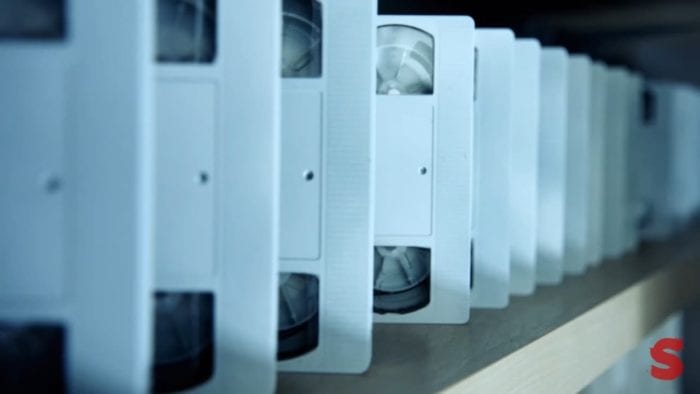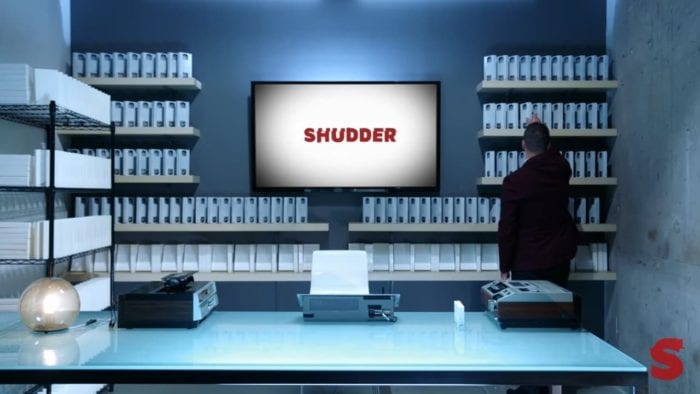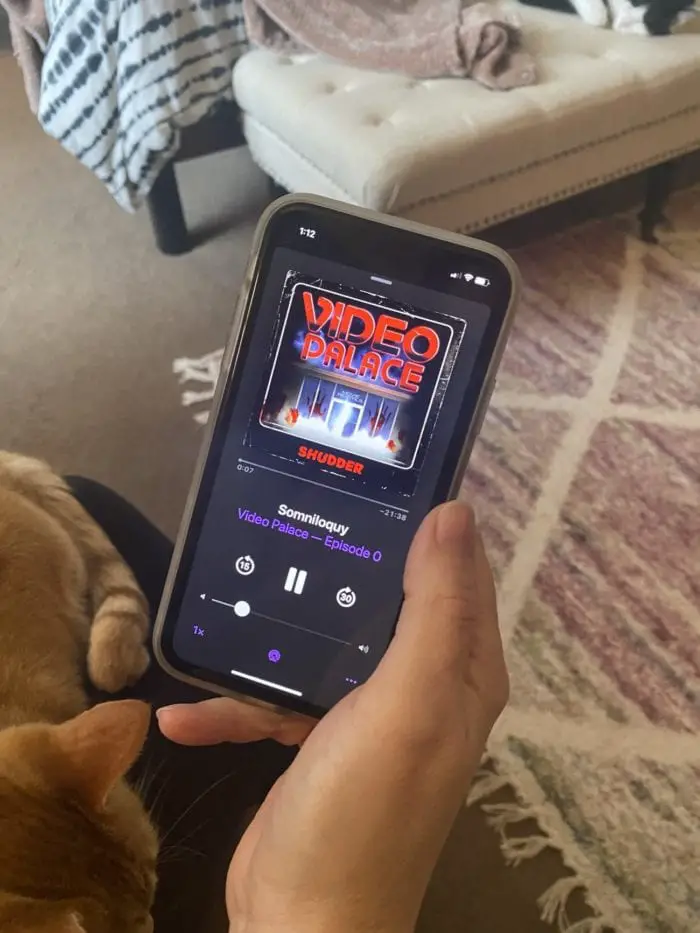“We are living in a day when there are no more secrets when my twelve-year-old nephew can buy his own grimoire, and books with titles like The Encyclopedia of Ancient and Forbidden Knowledge are remaindered at every discount store. Though my friends from the ’20s would have hated to admit it, the notion of stumbling across some moldering, old ‘black book’ in the attic of a deserted house—some lexicon of spells and chants and hidden lore—is merely a quaint fantasy. If the Necronomicon actually existed, it would be out in paperback with a preface by Colin Wilson.”
–T.E.D. Klein, Black Man with a Horn
I’m Mark Cambria and this is the story of a strange videotape and a real mystery waiting to be solved. Welcome to Video Palace.
–Opening tag line for Video Palace Podcast
I’m a true believer in the well-chosen epigraph, a lesson I learned early from Stephen King novels and took to heart. I began this article with a lengthier one than I might normally choose because Video Palace, both as a narrative and as an example of a particular genre, exists as a refutation and challenge to the truth of Klein’s words. The truth is: mystery is dead, the black magic has been spent, and what there is to be found has already been found, studied, and monetized.
The counter-thesis presented in Palace runs like this: book-magic is dead, the archaic printing-press technology that gave us the greatest grimoires and darkest texts have died for sure, with maybe a few echoes left in mimeographed zines, chap-books, and cult-manifestos rotting in some ’60s acid head’s shoe-box of memories. But…there’s another archaic technology, only around for about 20 years, encoded, magnetic sigils on the blackest of tape in the blackest of black boxes. It’s not the mass-produced tapes that keep the mystery, it’s the blank cassettes, bought and recorded and then recorded over, half-recorded over, improperly erased; or the small-batch tapes produced by micro-studios too small to be remembered and too ephemeral to have left any trace other than black-plastic tombstones.

It’s clear that Video Palace creators, Nick Braccia and Michael Monello, have a love for the VHS collector subculture. Between multiple references to Tales from the Quadead Zone to interviews with horror media influencers and collectors (both real and imagined, they drop enough shibboleths to let us know—they get it. The first white videotape our protagonist, Mark Cambria, encounters arrives as part of a bulk-lot of tapes bought off eBay (surely a sacred rite of VHS collector passage), nestled between rows of black plastic, as conspicuous as a white stag and as ominous as a white whale, it quickly becomes an obsession.
Through ten episodes, a total running time of roughly three and a half hours, we follow Mark and his girlfriend, Tamra, from New York to a cult (through all meanings of the word) video store in the middle of nowhere Vermont. One of the strengths of Video Palace, especially in the build-up, is in its pacing. The writing and direction follow a very careful trajectory with Mark’s character from rational, curious newbie-podcaster through unbalanced, obsessive, detective work until he is finally consumed and absorbed by the Stack and the tapes. Obviously, part of the narrative success is due to the strength of Chase Williamson’s turn as Mark. It’s very easy to believe he is an avid This American Life and Serial podcast devotee, who’s lucky enough to stumble across a mystery tied up with his own pop-culture obsessions as a horror videotape collector.
The plotting and characterization are tightly controlled, and aside from a few sharp comments at Tamra, we don’t get a true sense of Mark’s crumbling psyche until his final comments at the very end of episode five, at the exact mid-point of the series overall when he narrates that “it feels like we’ve fallen into a pit where the darkness just keeps twisting down further and further, but if we keep going we’ll come out the other side, and we will see the light and then everything will be OK.” And from that point, the scales in Mark’s mind have flipped from a steady temperament losing its grip into a compromised mental state trying to keep itself together and play-acting at being the firm persona it was before.
He only keeps up the pretense of objectivity in order to keep Tamra, who is continually ready to bolt, at his side and it’s no wonder that her first segment apart from Mark is a visit to the mental hospital where the owners of the Video Palace were admitted on the same day. You get the feeling Mark wants to stay as far away as possible in his state. The opening tagline quoted at the beginning of this article serves as a good barometer throughout, each episode it is repeated at the same time, in the same firm and unhurried voice, and every episode grows progressively more disjointed from Mark’s current mental state and the illusion that what he is moving toward is something as anodyne as a mystery to be solved.
In fact, aside from a few scripted-sounding conversations with perky side characters, most of the acting in Video Palace is at a minimum workman-like all the way to outstanding. Two of the strongest are Devin Sidell as previously mentioned Tamra and Larry Cedar as piano-tuner/Video Palace member, Randy Wane. Tamra is the Ishmael to Mark’s Ahab and the writers use her character very purposefully throughout as a foil, as the voice of reason, and as the voice of the unease felt by the listener. They also use her structurally by allowing her to split off from Mark and narrate certain segments by herself early on, which prepares us for the jolt of later episodes narrated almost completely by her.
She is a stranger in a strange land in more than one way—the world of obsessed collectors in Video Palace is an almost exclusively male world. Characters around it, such as the female clerk, the wife of a collector, the wife of the store owner, have a place in the mystery but are outside the negative influence of the tapes themselves seemingly. Tamra even points out to Mark that she and her friend, Cat, viewed the same tapes that made him physically ill and lose time, and they were completely unaffected. It’s not really clear if this gender division is part of the lore of the white tapes, it’s never addressed, or maybe it’s a commentary on the gender imbalances at play in the world of hardcore collecting, for many years an almost exclusively male domain, which in the last couple of decades has fortunately opened up to everyone in a more balanced fashion. Now spouses and significant others of both genders are having to learn the fine art of making room for their partner’s ever-growing collections.
Prior to Video Palace, I knew Larry Cedar mainly as Pierce Hawthorne’s pedantically racist father, Cornelius, but after Palace, I may remember him more for Randy. I am determined to give away as few spoilers as possible in this article—I hope to encourage as many people as possible to listen and don’t want to steal the furniture while I give the tour, but in the case of Cedar’s Randy Wane character, I feel justified in being a bit of a spoiler. Mainly because Randy is so great at being a friendly antagonist that you can’t help but seeing it a long way coming. My wife and I enjoy accusing every other person we see in a crime show by declaring when they walk on screen—they did it. Because we say that about roughly two-thirds of the characters we usually are right. I wasn’t playing that game with Video Palace but the moment Randy began talking, I immediately thought—he did it. That is not to take away from his performance, it’s a challenge of the writing to hide the ball on such a dynamic character, especially when the actor does such an outstanding job at giving it life, a real feat when they have only their voice.

Randy provides one of the running spooks of the podcast when he is sent into a trance by the playing of a white tape, during which he approaches a piano in his shop and begins to play a short, dissonant tune over and over. This is the occasion for the first genuinely Lovecraftian touch as Mark swears he sees a patch of darkness wavering over the piano as the tune is played, part of the mystery for us is whether this is Mark losing his grip or something more objectively real. We eventually learn that this tune is something called a tritone. All of which is explained by Cat Dash, Tamra’s best friend, musician, and horror movie soundtrack composer. Cat plays the part of that most unfortunate of horror movie trope characters—the expositor.
Turns out horror movies based on cults or the occult often have convoluted or complex lore that can be difficult, if not impossible, to adequately dramatize, so a creator has a choice—leave it alone and let the mystery remain or create a character to verbalize some of the more esoteric corners of your script. If a writer chooses the expositor adventure, the success or failure usually depends on how seamlessly they can integrate the mass of dialogue into a natural-sounding conversation. Video Palace mostly succeeds at that challenge, this is ostensibly an investigative podcast after all, so the explanatory dialogue has a more rightful place here.
Cat’s role as a sound engineer sets a theme around the use of sound in Video Palace. The first problem, I suppose, around a podcast about VCR tapes is discussing a visual medium through sound only. Concurrently, the audio nature of the podcast also sidesteps the converse problem of the reveal. Take the Ring, for example, another story revolving around unusual videotapes. Once we see the video itself, it is never as scary as we imagined, it can’t be, a problem as old as the horror genre itself, but I would have felt cheated if it had never been shown to me. Horror fiction in a written form never had the same problem, I’d like a description of the monster beyond the door, but even if I never do because of the crumbling sanity of the narrator, I don’t feel as cheated on the page as on the screen, because I know that any information must come through the narrator, whereas the camera can give me a clear picture, protagonist sanity aside, so it becomes a much more apparent dodge. For example, we understand inherently in Lovecraft’s “Music of Eric Zann,” that we’ll never hear the music. How could we in a written work? The author is free to make his description of its powers as unlikely and improbable as he wants and never has to produce. The opposite can be felt in Sam Raimi’s Evil Dead series, we get brief glimpses of the Necronomicon, but we don’t expect a lot of time to be spent on-screen reading through long passages of the book itself, a few suggestive glimpses will do.
Video Palace as a purely audio format rides the line between both these problems, with the strengths and weaknesses of each. The solutions they employ are pretty successful in both withholding and giving enough that the listener doesn’t feel like it’s a dodge. Randy provides the first important clue when he plays the tritone in a trance, something he denies having done later on. Cat then fills in the missing pieces by explaining that the tritone is the most discordant note in music, also called the diminished fifth, also called the Devil’s Tone, banned by the Catholic church in the middle ages. Her character is charming enough to make five minutes of fairly technical music theory less awkward. Mark receives random voicemails throughout the series of the same tritone being played, often at out-of-the-way places, like hotel room phones where no one should know he is staying. The interesting point is that most of the history lesson is true, and the physical impact of the tritone is legitimately discordant and unsettling, it gives a sense of very real grounding in reality for the physical aspects Mark experiences while suggesting a whole hell of a lot more.
Giving the texture and tactile aspect of the cassette tape is another important aspect of the production. At certain times, that is not limited to just videotapes, answering machine tapes, and reel-to-reel voice recordings play important roles at times. The first and, for the video collector, the most satisfying sound effect will always be slipping the tape into the machine, giving us that beautiful clunking and whirring as the machine grabs hold and locks the tape in place. Imagining Video Palace without that noise would be like finding out the white tapes are just a collection of home movies recorded on albino oddities. There is a long section where Cat works to combine the audio tracks of the different tapes Mark has found, and she explains that each tape fills in a different part and combine for something greater than the individual. The listener has heard each tape individually as Mark listens to them, besides his narration of the visuals, which the medium allows to be vague without feeling like a cheat, we hear heavy doses of the static interference and stretched-tape warping we have all come to associate with the VCR experience. As it turns out, the creators of Video Palace are relying on that lack of visuals to carry the story forward, some of the reveals and turns would have been harder to pull off if they had been forced to show them in a film version of the story.

While it is a white tape that begins the whole series, it’s the video membership card slipped into the plastic of the clamshell case (I enjoy all those words together) that leads Mark to the real center of the puzzle. A membership card for Thurman Mueller, played by long-time character actor, Leon Russom. If Randy Wayne plays his character uncomfortably friendly and laid-back, Thurman is unmitigatedly creepy from start to finish. He has been missing for almost 20 years by the time Mark begins his investigation, so all the glimpses we have from him come from the found-footage aspect of Video Palace. Each of the times we hear his voice become the cornerstones Palace is built around. We get our first real glimpse of something more to these tapes when we hear a recording of a police interview of Mueller regarding a break-in of a fellow collector’s home. Thurman tells the detective that he can’t stop “until we open the eight doors” which are “doors to the Stack…in the basement.” We hear his voice again on a tape from the Video Palace answering machine, given to Mark decades after it burnt to the ground, but to discuss it would give away one of the creepiest and most effective parts of Video Palace, so I’ll let you hear that for yourself.
Video Palace is a lot of fun, has some real storytelling heft to it, and makes complete use of the podcast format, something that has been tried many times but most successfully here. It isn’t afraid to utilize film nostalgia (whether it’s the opening theme that sounds a lot like the main theme of the Schwarzenegger classic, The Running Man, or the episode named after the bad guy in Scanners) without it ever feeling like a crutch. It is firmly horror in the Lovecraftian tradition without a lot of the narrative—excesses that can bring with it. Much of that restraint is due to its strict adherence to the emotional territory staked out by Ira Glass and the NPR universe, even when Mark is losing it, he tries to report accurately what he thinks the stakes are and what his reasoning may be, no matter how compromised. The aural picture created by the sound-effects is spot on and nothing ever feels so outrageously out of place as to be distracting, beyond the occasional refusal of the characters to recognize the reality of the danger in front of their face. Video Palace was a Shudder Original exclusive to their channel but is now available on iTunes and Spotify, as well as Shudder’s Youtube channel. The episodes are concise and well-edited, and worth the minimal time investment for a great story that can give you goosebumps on our never-ending weekends in.
Looking for more from Shudder? We’ve got you:
“The Power Provides Many Jump-Scares Underneath Its Message”
“Rape, Revenge, and Realism in Violation”
“Koko-Di Koko-Da Frustrates and Impresses in Equal Measure”
“Psycho Goreman Hits Blu-Ray and It’s Heckin’ Great”
“‘Shook’: One Night of Masterful Social Media Terror”
“Shudder’s After Midnight Tells the Story of a Genuine Relationship”
“Head Count: A Fun, Modern Creature Flick”
“Before the Fire Is an Admirable Pandemic Thriller”
“The Untamed: A Hidden Seduction in the Hills of Mexico”



